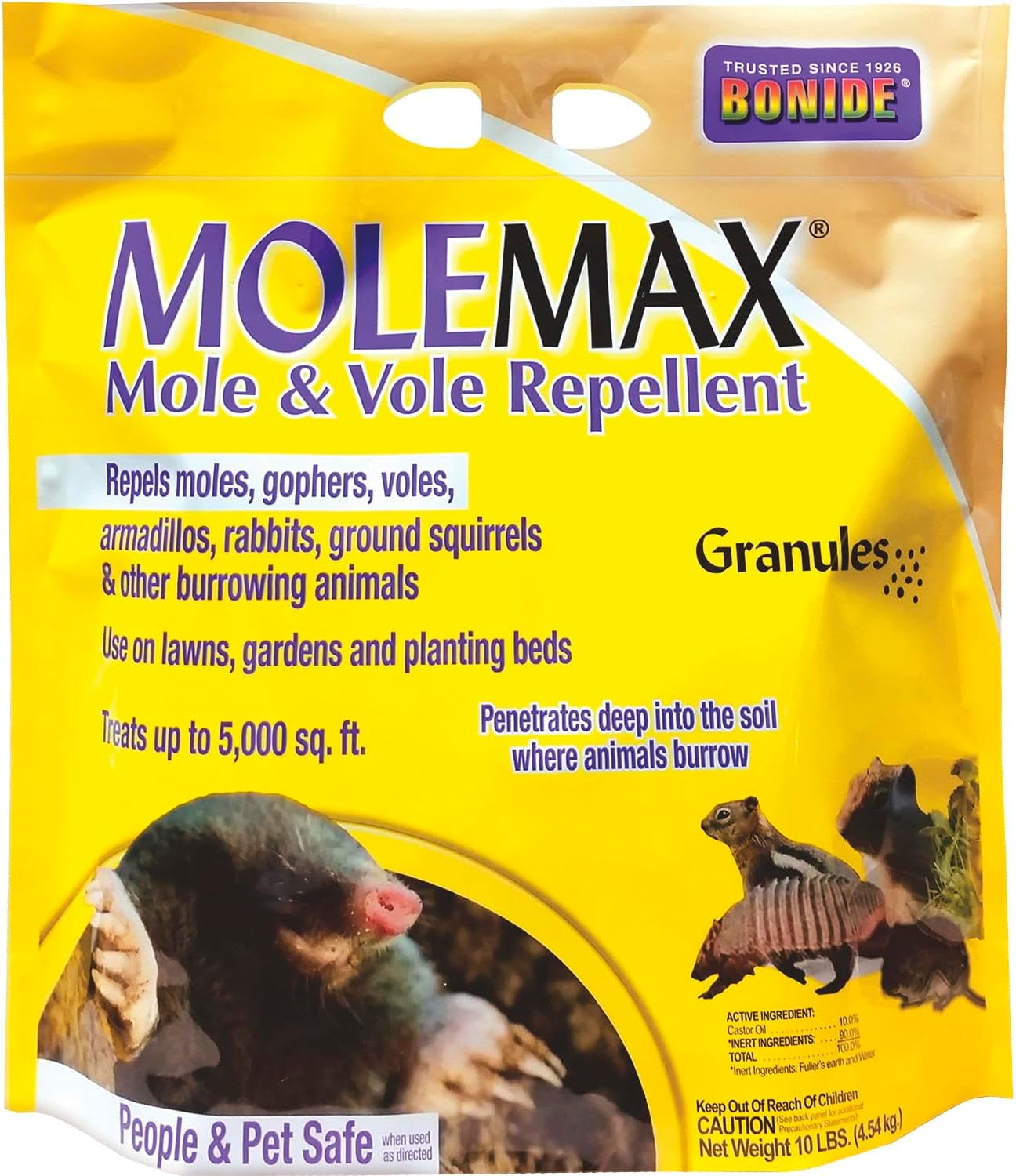Mole Control & Removal
Moles are insectivorous mammals that can cause significant lawn damage through their tunneling activities. While they help control grubs and other soil pests, their extensive tunnel systems can destroy grass roots and create unsightly surface ridges. Understanding mole behavior and their feeding patterns is crucial for implementing effective control measures.
Recommended Products
Bonide MOLEMAX Repellent
A natural castor oil-based granular repellent that protects lawns and gardens from burrowing pests. This ready-to-use formula treats up to 5,000 square feet and provides up to three months of protection while remaining safe for plants.
- Natural Ingredients
- Extended Protection
- Wide Coverage
- Plant Safe
CritterTec Solar Mole Repellent Stakes
Humane solar-powered stakes that emit sonic waves and vibrations to deter burrowing pests from your yard. Each set covers up to 5000 sq.ft with eco-friendly, continuous protection for up to 7 days on a full charge.
- Solar Powered
- Wide Coverage
- Weather Resistant
- Pet-Safe Operation
Natural Elements Mole Repellent
A pure 100% castor oil repellent that naturally deters moles and voles by disrupting their sensory perception. This eco-friendly gallon formula treats up to 20,000 square feet with long-lasting protection that's safe for pets, plants and the environment.
- Pure Castor Oil
- Extensive Coverage
- Eco-Friendly Formula
- Sensory Deterrent
⚠️ Health & Safety Risks
- Lawn damage
- Trip hazards
- Root system damage
- Foundation undermining
- Equipment damage risk
🚨 When to Call a Professional
- Extensive tunnel systems
- Failed DIY attempts
- Structural concerns
- Large property damage
- Multiple moles present
🏥 Emergency Response
- Ground collapse: Fill holes immediately
- Utility damage: Contact service provider
- Foundation issues: Consult engineer
- Injury from holes: Seek medical care
- Property damage: Document for insurance
🔍 Identification & Signs

Gopher vs Mole - What's the Difference?
If you’ve discovered holes, wilted plants, or mounds of dirt disrupting your lawn or garden, you’re likely dealing with underground…
Read More →🏡 DIY Removal Guides

DIY Mole Removal: 7 Effective Home Remedies to Get Rid of Moles in Your Yard
Discovering mole tunnels and molehills in your carefully maintained lawn can be frustrating. While these underground creatures play a beneficial…
Read More →🔬 Professional Solutions & Products

Best Mole Repellents: Ultimate Guide to Keeping Moles Away From Your Property
Moles can wreak havoc on your carefully maintained lawn and garden, creating unsightly tunnels and destroying plant roots. While they’re…
Read More →🦔 Related Pests
Often confused with:
🔍 Signs of Activity
- Raised tunnels
- Volcano-shaped mounds
- Dead grass strips
- Surface ridges
- Collapsing soil
🏠 Common Areas
- Lawns
- Gardens
- Golf courses
- Moist soil areas
- Shaded grounds
Frequently Asked Questions
How do I know if I have moles?
Look for raised tunnel ridges in lawn, volcano-shaped dirt mounds, and dying grass along tunnel paths. Active tunnels will be repaired quickly if stepped on.
What attracts moles to my yard?
Moles are attracted to areas with abundant soil insects, especially grubs, earthworms, and other invertebrates. Moist, well-maintained lawns often harbor these food sources.
Do mole repellents work?
Most commercial repellents show limited effectiveness. Physical barriers, trapping, and reducing food sources typically provide better results.
How deep do moles dig?
Moles create surface tunnels 1-4 inches deep for feeding and deeper permanent tunnels 6-24 inches underground for traveling and nesting.
Will removing grubs get rid of moles?
Grub control alone may not eliminate moles since they also feed on earthworms and other soil insects. A comprehensive approach is usually needed.
How many moles live in a yard?
Moles are solitary animals. One mole can create extensive tunnel systems, making the problem appear worse than it is. Usually only 2-3 moles per acre.
Can moles damage foundations?
While rare, extensive tunneling near foundations can potentially cause settling or water drainage issues. Monitor activity near structures closely.
What's the fastest way to get rid of moles?
Professional trapping is usually most effective for quick results. Combined with habitat modification and barrier installation for long-term control.
Do sonic devices work?
Scientific evidence for sonic/ultrasonic device effectiveness is limited. Physical control methods are generally more reliable.
How long does mole control take?
Initial control can take 1-2 weeks, but complete elimination and lawn restoration may require several weeks to months of monitoring and maintenance.


